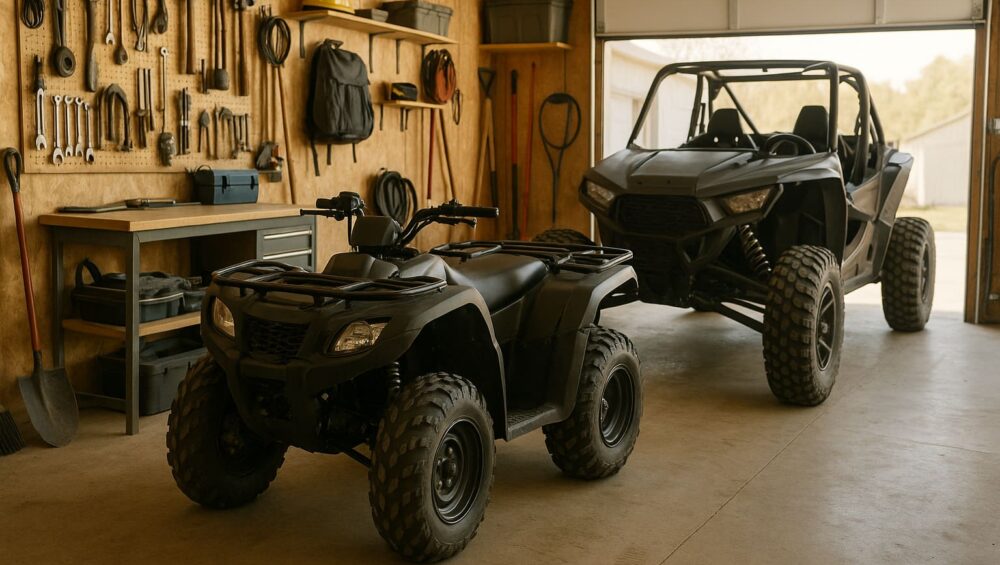When it comes to off-road adventures, picking the right vehicle is crucial to your experience. While dune buggies and ATVs both offer great thrills, they cater to different terrains, activities, and budgets. But how do you decide which is right for you?
This guide compares dune buggies and ATVs across several factors, from design to performance, safety, and use cases. By the end, you’ll know which off-road vehicle aligns with your lifestyle and needs.
Understanding the Basics – Dune Buggy vs ATV
Before we jump into comparisons, knowing what each vehicle brings to the table is key.
What is a Dune Buggy?
A dune buggy is a lightweight, open-frame vehicle designed specifically for off-road terrains like sand dunes and beaches. Its standout features include:
- Four wheels and wide tires designed to glide over soft surfaces.
- Open frames and roll cages for safety.
- A rugged, adventurous design ideal for open spaces.
Typically, dune buggies are used in desert terrain or sandy areas, making them a favorite for thrill-seekers chasing big, soft dunes and sprawling beaches.
What is an ATV (All-Terrain Vehicle)?
An ATV, or All-Terrain Vehicle, is a compact, single-rider (or up to two-person) vehicle. It’s incredibly versatile, capable of navigating mud, snow, forests, dirt trails, and more. Key ATV features include:
- Handlebar steering for tight and precise control.
- Variety of builds like quad bikes, 3-wheelers, and even six-wheel utility ATVs.
- The perfect fit for rugged and narrow trails.
While less specialized than dune buggies, ATVs shine in versatility and accessibility.
Key Differences Between Dune Buggies and ATVs
Now that we’ve defined each vehicle, let’s dig into how they differ in terms of design, terrain compatibility, and passenger capacity.
Design and Build
- Frame Structure
- A dune buggy has a larger, open-frame design featuring a roll cage for added safety. Its steering wheel and bucket seats give you a car-like feel.
- Meanwhile, ATVs adopt a compact, motorcycle-like frame. Riders straddle them, gripping the handlebars for steering.
- Safety Features
- Dune buggies rely on seat belts, harnesses, and roll cages for protection.
- ATVs depend on helmets, padded gear, and proper riding posture for safety.
Terrain Suitability
- Dune Buggies excel in wide, open spaces like deserts and beaches. Their wide tires and longer wheelbases make them perfect for navigating sand without sinking.
- ATVs, on the other hand, offer unparalleled control in tight trails, rugged terrain, and even snowy landscapes. They’re the go-to option for forest rides and steep inclines.
Passenger Capacity
- Dune buggies often seat 2–4 passengers, making them family-friendly for outings.
- ATVs are typically meant for single riders or, in some designs, two passengers. If you’re riding solo, an ATV might be the simple and lightweight choice.
Performance Comparison
Performance plays a huge role in choosing between a dune buggy and an ATV. Speed, comfort, and fuel efficiency each vary significantly.
Speed and Handling
- On Open Terrain
Dune buggies, with their larger engines, dominate in high-speed sand racing. They’re less agile on tight corners, but unbeatable on straight stretches.
- On Tight Trails
ATVs win the day. Thanks to their smaller size and precise handlebar steering, they’re built to weave through narrow tracks with ease.
Suspension and Ride Comfort
- Dune buggies come equipped with robust suspension systems to absorb shock, ensuring a smoother ride on bumpy sand dunes.
- ATVs, while offering decent suspension, can feel less forgiving during long or rocky rides, especially with frequent jolts.
Fuel Efficiency and Range
- ATVs tend to consume less fuel due to their lighter weight and smaller engines, allowing for longer distances on a single tank.
- Dune buggies, while powerful, usually guzzle more fuel, limiting how far you can go without a refill.
Cost and Maintenance
Your budget will heavily influence your decision between a dune buggy and an ATV. Here’s what to expect in terms of costs.
Purchase Price
- Dune buggies range from $5,000 to over $50,000, depending on size, brand, and customizations.
- ATVs are more affordable, starting at $3,000 and going up to $15,000 for specialty models.
Maintenance Needs
- Dune Buggies may require more frequent and expensive maintenance. Their larger engines and specialized parts sometimes mean higher costs and longer repairs.
- ATVs are easier and cheaper to maintain, with spare parts widely available.
Insurance and Legal Requirements
- Dune buggies often need special insurance and registration. Depending on your region, you may also face restrictions on road use.
- Many ATVs require minimal paperwork, but insurance and helmet laws still apply in most areas. Always check your local regulations.
Safety Considerations
When it comes to safety, both vehicles require proper precautions, but accidents and risks present differently.
Protective Gear Requirements
- For Dune Buggies
- Seat belts and roll cages are standard. Drivers typically wear helmets, especially in high-impact areas.
- For ATVs
- Helmets, gloves, boots, and padded riding jackets are must-haves to protect against falls and collisions.
Accident Risks
- Dune buggies offer strong protection due to their sturdy build and roll cages. However, their weight and size make rollovers sometimes serious.
- ATVs carry a higher risk of rollovers, particularly on uneven or steep terrain, due to their smaller size and center of gravity.
Use Cases and Lifestyle Fit
Finally, consider how these vehicles align with your lifestyle, from recreation to work-related uses.
Recreational Use
For casual weekend fun or family outings, dune buggies provide a safer and more social experience. Their larger size and seats make them ideal for group activities. ATVs are best for adrenaline junkies seeking solo adventures on challenging trails.
Utility and Work Use
If you’re looking for functionality beyond fun, ATVs win hands-down. Farmers, hunters, and outdoor workers rely on ATVs for hauling, towing, and navigating rugged areas. Dune buggies primarily remain in the realm of sport and leisure.
Transport and Storage
- Dune buggies are bulkier and can be a hassle to store or transport without robust towing.
- ATVs are easier to tow, store, and fit into smaller garages or trailers.
Choose the Right Vehicle for Your Needs
The choice between a dune buggy and an ATV comes down to how, where, and why you want to ride. If you crave high-speed adventures across dunes and value passenger capacity, a dune buggy might be your perfect match. For versatility, quick trail rides, or utility purposes, an ATV could be the ideal fit.
No matter which you choose, remember that safety and maintenance are as important as the ride itself. Whichever path you take, the world of off-road excitement awaits!






